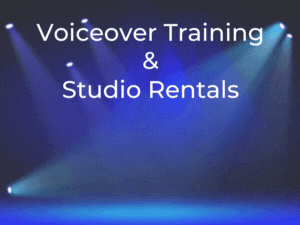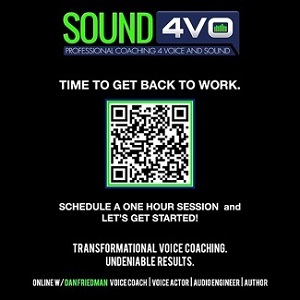|
How To Construct A Bare-Bones
'Affordable' Voice-Over Home Studio
By Peter Drew
© Peter Drew 2005, 2007 To make a living, voice-over talents used to have to physically go to gigs recorded in commercial production facilities. Now, gigs can come to them - in home studios and through the Internet.
But for many voice-over talents, newbie and old pro alike, outfitting a home studio is technically baffling.
So, how do you make that spare bedroom or corner of your studio apartment (no pun intended) into a functional voice-over facility, with decent acoustics and the appropriate equipment?
Let's take a look at the basics involved in setting up a home voice-over studio.
SELECTING STUDIO SPACE
A studio of any size or recording purpose starts with the space in which it will be located.
Isolation from outside sounds is important.
If you live in a studio or one-bedroom apartment, then try to locate your "studio" in a corner as far from the door to the hallway and away from windows. Also, a closet can work well as a recording booth. Set up your recording equipment just outside the closet and your microphone inside the closet.
If you live in a two-plus bedroom unit or a single-family home and can dedicate an entire room to your studio, then you'll have more options available for controlling the acoustics of the space. ACOUSTIC SOLUTIONS
You'll want to make sure the room doesn't sound too "echoey" or "hollow." Treating these problems can be as simple as putting some overstuffed furniture in the room, along with a rug and some drapes over the windows.
Have a lot of old clothes sitting in an attic or basement? You can use them to create a recording "booth" around your mic. Fill three or four rolling clothes racks with clothes and then position them on the sides and back of your mic position.
Of course, you can use professional acoustic materials to control sound reflections. You'll find an excellent primer on acoustical treatment - in plain English - at Auralex. Check out these acoustical treatment production companies, too: HSF Acoustics; Silent Source; Vocalbooth; Whisper Room. SELECTING EQUIPMENT
Once you have your studio space selected, you'll need to properly equip it in order to deliver pro quality voice-overs to clients. With the latest in digital recording technology and reasonably-priced pro microphones, you could spend as little as $1,000 for a very basic, yet serviceable, home voice-over studio. That's assuming you have a decent computer sound card and speakers.
The list is quite short:
Bare bones, but it will work.
PLUG IT WHERE?
Load the recording/editing software. A couple of adjustments to volume "in" and "out" and you're ready to record.
Voice the copy. Clean it up with an edit or two. Then convert the voice-over sound file to an .mp3 file, attach it to an email, and send it off to the client via the Internet.
EQUIPMENT SOURCES
To learn more about the equipment listed above, search the web or visit online pro audio dealers. A few good ones are: zZounds, Full Compass; Sweetwater; B&H Pro Audio; Boynton Pro Audio; BSW.
This simple studio set up is serviceable, but it has its limits. If a client wants to direct you via the phone, then you'll have to either hold the phone to your ear while you record, or get a hands-free headset. The best way to take direction over the phone is to buy a gizmo called a phone hybrid that allows you to speak through your mic down the phone line to your client as you listen to the client's direction through your headphones.
LEARN MORE ...
As with any investment, you'll want to research the equipment you'll need for your studio, and how to install and use it.
See if you can locate a voice talent in your area who may let you visit his or her studio.
Visit Mix Magazine or EQ Magazine and check their archives for articles on home studios.
Local production houses may be willing to make suggestions, but, remember, by setting up your own studio, you're indicating to clients that they can cut out the production house by working directly with you.
That may not sit well with some production house owners, because the home voice-over explosion has had a detrimental impact on many commercial recording facilities.
YOU CAN DO IT
That's a basic home voice-over studio in a nutshell. If you can operate a home stereo and have experience in front of a computer screen, then you can put together and operate a home voice-over studio. With a little practice recording and editing, and some promotion of your home studio, you can quickly recover the cost of your studio and begin to add to your bottom line. Happy voicing!
Peter Drew, a freelance voice-over talent and copywriter/producer with decades of experience, is heard on radio and television stations, corporate presentations, web sites, and messages-on-hold across America and countries around the world. To send an email regarding this article, please visit Peter Drew Voiceovers at http://www.peterdrewvo.com
 |
|
|
Tell Us What YOU Think!
Please Note: Since we check for spam, there will be a slight delay in the actual posting of your comment.
Comments (1)
Sinead Bolton
5/3/2020 at 4:44 PM
I have always modelled my home studios using a blueprint for a hearing test booth - the noise cancellation is ideal and I find them much easier to replicate - https://www.iacacoustics.global/audiology-test-rooms/








.png)
click for new article alerts